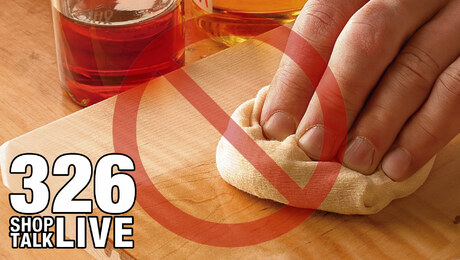STL 139: The horrors of moving your shop
Plus, the guys talk about how they make drawer stock, tablesaw horsepower, roll around carts, and making a miter sled for a benchtop saw**Web producer’s note – I’m on a shoot right now so I haven’t had a chance to add links. Check back on Monday. Apologies – Ben
Fill out our Shop Talk Live listener survey. Unfortunately, due to the overwhelming response we can no longer offer free stickers in return for filling out the survey.
02:48 – Question 1:
I recently got my shop set up very nicely. Now I have to move. Should I just kill myself or is there a better way? I’d love some advice on moving large machines, parting with jigs, saving jigs, neat pieces of wood, useful pieces of wood, containers of potentially useful junk and all that stuff that some of us collect in our shops. I’m just overwhelmed by this looming event and want advice.
-Noah
12:00 – Question 2:
How do you guys managed material for drawer sides. Say you were making a cabinet with multiple drawers, the final thickness for the drawer sides you wanted to be 1/2 and in thick, would you get 4/4 stock plane it down via thickness planer or is it better to get 5/4 stock and resaw?
-Arthur
17:35 – All Time Favorite Tools of All Time… for this week:
28:15 – Question 3:
I’m hoping to get a new tablesaw soon. I’m wondering if I should get a 1 3/4 HP or the 3 HP model? I have the rough wiring in place for 220 volt single phase, but so far I have all 110 volt machines. Is the extra power of the 3 HP saw worth the effort of completing the wiring?
-Jim
31:00 – Question 4:
I do my woodworking in a community workshop and I’m looking to build a mobile shop cart to keep all my tools and have a little bench top for assembly and other sorts of things. I remember watching Matt’s router table build a while ago and he made a rigid base to support the casters and cabinet. Do you think the the rigid base is necessary? I want to maximize the amount of space I have inside the cabinet. Also, for the casters should I have two non-swivel in the back and two locking swivel in the front?
-Cameron
36:35 – All Time Favorite Technique of All Time… for this week:
51:16 – Question 5:
I have a portable table saw on a stand. I want to use a miter sled on the saw but there isn’t enough table between the blade and edge to balance the sled on. I’m in the process of building an infeed table, but, is this the best option?
Ideally not spending another 2k on a table saw would be nice.
-Mike
 |
 |
 |
|
Tom McKenna |
Michael Pekovich |
Ben Strano |
Every two weeks, a team of Fine Woodworking staffers answers questions from readers on Shop Talk Live, Fine Woodworking‘s biweekly podcast. Send your woodworking questions to [email protected] for consideration in the regular broadcast! Our continued existence relies upon listener support. So if you enjoy the show, be sure to leave us a five-star rating and maybe even a nice comment on our iTunes page.




















Comments
Wow, that fixture for positioning work on the mortiser table was amazing! But you all just kind of skipped over it... Suggest a brief article to make that concept available to others... Maybe also apply to other operations.
73
Nice episode, folks. I am remodeling/updating my shop (small two car garage). I'm having a 100 amp panel installed in the shop, and the electrician wanted the stud bays exposed. I've taken down everything on the walls and put it in boxes for safekeeping. Once the electrical work is done and inspected, I'll go back with drywall on the common wall with the house, and 15/32" plywood sheathing over everything. I marked out my studs with black paint on the floor and ceiling, and the lighter stuff I can just screw to the wall. BTW, I've moved my shop 4 times, and it is a nightmare. The last move, (and I mean the LAST move) the crew tried to stand my 8' x 26" x 37" solid beech bench on end for some stupid reason. They didn't look to see the planing stop hanger bolts on that end. I had to replace the knobs and straighten the bolts. I've always carried my handtools with me. Too precious to trust to the movers.
For cutting miters using a sled discussion... You can make the front face of the sled notched for wide moulding. By notch I mean having an opening or cutout of the front fence so you can side the moulding through the opening. This will allow you cut any and all moulding on the left and right side of the triangular fixture of the boat/sled.
FR
In defense of the radial arm saw.
I agree with you. The radial arm saw is likely the greatest tool bomb ever invented. They were always out of square, never at the right angle to the table and the table was never on the same horizontal plan as the motor. But back in the bygone years it was the one tool to have in the small shop. I made numerous projects with the aid of it including shelving units, toy chests, desks with drawers and countless other objects. I made puzzle boxes and a replica of a grocery store that was used for for linguistic experiments at a major university. It would cross cut, rip boards to width, cut dados and molding, all poorly and not to mention dangerously. So I have a soft spot in my heart for that beast and I still have one in my garage shop. It is limited on one operation that I do fairly often. I use it to cut splines on picture frame miters. The blade is set parallel to the table. Custom made guards of plexiglass sit on blocks. surround the blade and a vacuum port extracts dust. Stock is clamped to a board that sits on the table and the slot is cut by sliding the stock across the blade. Over the years I have cut hundreds of splines this way. I still have all ten. Enjoy the show.
I agree with everything Matt said regarding moving his shop. I am in the process of moving my shop at this very point in time.
I have been renting shop space for 6 years and just recently built a shop in my back yard. The payout should be about 6 years, but I digress.
One thing no one mentioned. After all of the boxing, moving, lifting, gnashing of words and mashing of fingers, you have to do all again in reverse. Oh Happy Days.
Love these shows guys.
I moved my shop and also had nightmares before I did it. My shop was in the basement of a 1939 bungalow with the only way out being the old stairway. I had gotten a 6" jointer, 13" planer, two bandsaws, dust collector, new delta 3hp Unisaw, spindle sander, 6x48 belt sander, lathe, etc... all down there. Thought it would cost thousands to get it all out. I found a local safe moving company and they hauled it all out and brought it to my new walk-out basement shop. They had all the equipment to move the heavy tools. $1100....an amazing deal. So try hunting down moving companies that specialize in heavy equipment moves.
Log in or create an account to post a comment.
Sign up Log in